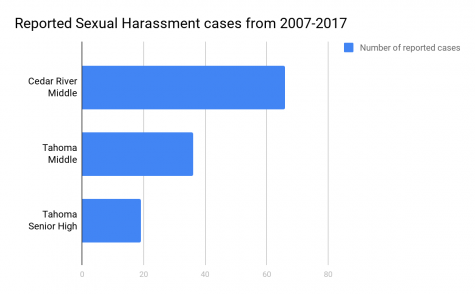Sexual Harassment in the Tahoma School District
in the wake of a national conversation about sexual harassment, Tahoma looks to its own practices
A photo from the 2018 Women’s March in Seattle on January 21st protesting sexual harassment among other social issues.
January 23, 2018
Sexual harassment and assault have been in the news lately. From the President of the United States to Today Show host Matt Lauer, women and men across the nation are saying time’s up.
Tahoma School District is not without sexual harassment, no school district is. However, trends in data collected through Tahoma’s Human Resource department from as early as 2007 to this current school year, 2017-2018, show where cases are most concentrated. It is also important to recognize that severe cases involving police enforcement would not be included in this set of data. The information provides a picture, if not a complete one.
At Tahoma Senior High School, from 2007 to 2018, there have been exactly twenty reported cases of sexual harassment. Interestingly, going down in grade level sharply increases these numbers.
Between 2008-17 at Cedar River Middle School, which no longer exists due to expansion in the school district, sixty-six reported incidents of sexual harassment were reported. In contrast, between 2007 and 2017, Tahoma Middle School, which also no longer exists, experienced thirty-six reported cases. The new middle schools, Maple View and Summit Trail, have experienced four and two cases respectively of reported sexual harassment in the 2017-2018 school year.

The principal of Tahoma Senior High School, Terry Duty, believes the reason for this is twofold: “First, it’s maturity. At the middle school, people don’t think before they act” said Duty.
Most of the descriptions of incidents of harassment at Cedar River, Tahoma Middle, and now Maple View and Summit Trail were inappropriate comments made by male students to another peer. Whether it was directed toward a female student or a male student was not always included in the report. The next most reported cases were unwanted touching of female students by their male peers.
“But I also think with the maturity comes ‘I can handle this,’“ explained Mr. Duty. At the high school level, Mr. Duty believes the mentality of students who are victims of sexual harassment is: “‘I don’t need to complain or report this,; ‘Nobody will do anything if I do.’”
His statements may not be too far off. At the high school level, a survey conducted by the American Association of University Women reports that 83% of females and 78% of male students in grades 8 through 11 have been sexually harassed. If Tahoma High School falls around these percentages then the 20 cases between 2007 and 2018 show severe underreporting by Tahoma students.
Additionally, Tahoma School District does not currently have an ombudsperson. An ombudsperson is an official representing the interests of the public and addressing and investigating complaints of maladministration or violations of rights.
“Sounds interesting” Mr. Duty acknowledged, adding that he hoped “teachers and administration would want to protect their [students] interests as well because that’s their job.”
In the Oakland Unified School District in California, there is now an ombudsperson at every school in the district. This was after a high school senior, Andrea Zamora, helped develop the policy.
Internationally, in the Netherlands, the country is working to teach students long before sexual harassment becomes a problem, starting at the age of 4. Kindergarteners are not taught about sex explicitly, rather, they are learning about sexuality. At 8 years old, students “learn about self-image and gender stereotypes. 11-year-olds discuss sexual orientation and contraceptive options.” The Dutch say the principle is “straightforward: Sexual development is a normal process that all young people experience, and they have the right to frank, trustworthy information on the subject” reports a PBS article on the country’s approach to sexual health.
“I don’t know about early, I think the more the better,” said Duty. He cites the new class called Foundations of Fitness for 9th graders, that has “a sexual development component built into it,” he explains.
Recently, members of the PTA have expressed concern about sexting among teens, and the Foundations for Fitness class has “really been a positive thing for our students,” said Duty. He went on to say “It’s empowerment. It’s education. And, the boys are standing up and saying it’s a respect thing.”
Mrs. Russell is a Tahoma High School Foundations of Fitness teacher. She feels schools should be starting sexual health education earlier: “I personally absolutely think that it’s critical,” said Russell.
She went on to explain, “I know sexual health education is controversial but when you look at health, in general, it deals with self-esteem development and if you’re learning about feeling good about yourself and respecting others, that gets to that prevention part,” said Russell.
Tahoma School District may actually be following the lead of the Netherlands as the new standards for K-12 Health and Physical Education have sexual health learning starting in Kindergarten. As the current curriculum shifts to the new Washington standards, Kindergarteners will learn about self-identity and the ways there are to express gender. Healthy relationships will even be explained at the kindergarten level, giving young children tools to recognize a good friend, to express their own feelings, and to recognize their ability, and the ability of others, to refuse giving or receiving an unwanted touch. The curriculum will advance as children advance in grade level and sexual abuse is designated to be defined at the 5th-grade level.
Moving forward, the goal of sexual health education may not be to emphasis where the ovaries are located in the female anatomy, but to teach children in their formative years the importance of respecting others. In turn, students will be able to recognize the importance of reporting misconduct because time is up for sexual harassment and assault.



